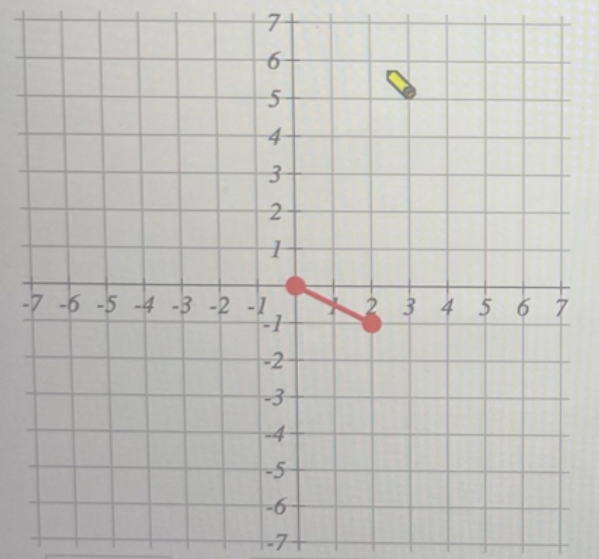The transformation of a function f(x) into a function g(x) is given by g(x) = Af(Bx + H) + K. where the constants • A vertically scales the function. (negative A reflects the function about the x-axis.) • B horizontally scales the function. (negative B reflects the function about the y-axis.) • H horizontally shifts the function. • K vertically shifts the function. Transform f(x) into g(x) where the transformation is g(æ) = 2 · f(x) The function f(x) is shown below in red. Graph the transformed function g(x) by first placing a dot at each end point of the new transformed function and then click on the "line segment" button and connect the two blue dots. (Hint: Use pattern-matching to determine the values of the constants A, B, H, and K.) 7- 5- 4- -7-6 -5 -4 -3 -2 -1 4 56 -2 -5 -6 -7+ Clear All Draw: Dot Line Segment
The transformation of a function f(x) into a function g(x) is given by g(x) = Af(Bx + H) + K. where the constants • A vertically scales the function. (negative A reflects the function about the x-axis.) • B horizontally scales the function. (negative B reflects the function about the y-axis.) • H horizontally shifts the function. • K vertically shifts the function. Transform f(x) into g(x) where the transformation is g(æ) = 2 · f(x) The function f(x) is shown below in red. Graph the transformed function g(x) by first placing a dot at each end point of the new transformed function and then click on the "line segment" button and connect the two blue dots. (Hint: Use pattern-matching to determine the values of the constants A, B, H, and K.) 7- 5- 4- -7-6 -5 -4 -3 -2 -1 4 56 -2 -5 -6 -7+ Clear All Draw: Dot Line Segment
Calculus: Early Transcendentals
8th Edition
ISBN:9781285741550
Author:James Stewart
Publisher:James Stewart
Chapter1: Functions And Models
Section: Chapter Questions
Problem 1RCC: (a) What is a function? What are its domain and range? (b) What is the graph of a function? (c) How...
Related questions
Question
100%

Transcribed Image Text:The transformation of a function f(x) into a function g(x) is given by g(x) = Aƒ(Bx + H) + K.
where the constants
• A vertically scales the function. (negative A reflects the function about the x-axis.)
• B horizontally scales the function. (negative B reflects the function about the y-axis.)
• H horizontally shifts the function.
• K vertically shifts the function.
Transform f(x) into g(x) where the transformation is g(x) = 2· f(x)
The function f(x) is shown below in red. Graph the transformed function g(x) by first placing a dot at each
end point of the new transformed function and then click on the "line segment" button and connect the two
blue dots. (Hint: Use pattern-matching to determine the values of the constants A, B, H, and K.)
4-
2-
-7 -6 -5 -4 -3 -2
-1
4
-2
-3-
-4-
-5-
-6
-7
Clear All Draw: Dot Line Segment
Expert Solution
Step 1
Given graph:-

To find:-
Transform f(x) into g(x) where the transformation is g(x) = 2 f(x)
Step by step
Solved in 3 steps with 2 images

Recommended textbooks for you

Calculus: Early Transcendentals
Calculus
ISBN:
9781285741550
Author:
James Stewart
Publisher:
Cengage Learning

Thomas' Calculus (14th Edition)
Calculus
ISBN:
9780134438986
Author:
Joel R. Hass, Christopher E. Heil, Maurice D. Weir
Publisher:
PEARSON

Calculus: Early Transcendentals (3rd Edition)
Calculus
ISBN:
9780134763644
Author:
William L. Briggs, Lyle Cochran, Bernard Gillett, Eric Schulz
Publisher:
PEARSON

Calculus: Early Transcendentals
Calculus
ISBN:
9781285741550
Author:
James Stewart
Publisher:
Cengage Learning

Thomas' Calculus (14th Edition)
Calculus
ISBN:
9780134438986
Author:
Joel R. Hass, Christopher E. Heil, Maurice D. Weir
Publisher:
PEARSON

Calculus: Early Transcendentals (3rd Edition)
Calculus
ISBN:
9780134763644
Author:
William L. Briggs, Lyle Cochran, Bernard Gillett, Eric Schulz
Publisher:
PEARSON

Calculus: Early Transcendentals
Calculus
ISBN:
9781319050740
Author:
Jon Rogawski, Colin Adams, Robert Franzosa
Publisher:
W. H. Freeman


Calculus: Early Transcendental Functions
Calculus
ISBN:
9781337552516
Author:
Ron Larson, Bruce H. Edwards
Publisher:
Cengage Learning